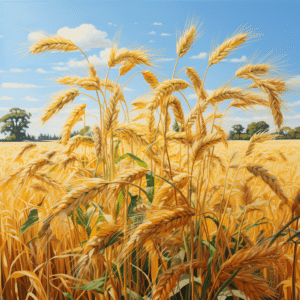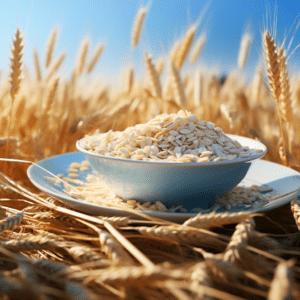Oats are an essential staple in agriculture, with a long history of cultivation. Growing oats requires careful planning and attention to detail, but with the right techniques, anyone can successfully grow this versatile crop. In this comprehensive guide, we will explore all the necessary steps to grow oats, from understanding the basics of oat cultivation to harvesting and storing the grains.
Understanding the Basics of Oat Cultivation

Before diving into the specifics of oat cultivation, it’s important to grasp the significance of oats in agriculture. Oats are not only a valuable source of nutrition for both humans and livestock but also play a vital role in sustainable farming practices. Oats are known for their ability to improve soil health, prevent erosion, and provide abundant ground cover.
When it comes to oat cultivation, there are various oat varieties to choose from. Each variety has its own unique characteristics and requirements. Some popular varieties include hulled oats, naked oats, and winter oats. Understanding the differences between these varieties will help you make informed decisions throughout the growing process.
Hulled oats are the most common type of oats grown for human consumption. These oats have a tough outer shell that needs to be removed before they can be eaten. The process of removing the hulls involves threshing, which separates the oats from the chaff. Hulled oats are often used in breakfast cereals, granola bars, and baked goods.
Naked oats, on the other hand, have a looser husk that easily falls off during harvesting. This eliminates the need for threshing and makes the oats more suitable for livestock feed. Naked oats are also known for their high protein content, making them a popular choice among farmers looking to provide their animals with a nutritious diet.
Winter oats are specifically bred to withstand colder temperatures and are sown in the fall for harvest in the following spring. These oats have a longer growing season compared to other varieties, allowing them to develop deeper root systems and better resistance to diseases and pests. Winter oats are often used as cover crops, helping to prevent soil erosion during the winter months.
Regardless of the oat variety chosen, successful cultivation requires careful consideration of factors such as soil type, climate, and available resources. Oats thrive in well-drained soil with a pH level between 6 and 7. They prefer cool, moist conditions and can tolerate light frosts. However, extreme heat and drought can negatively impact their growth and yield.
When preparing the soil for oat cultivation, it’s important to remove any weeds or debris that may hinder their growth. This can be done through plowing, harrowing, or tilling, depending on the size of the field. Adding organic matter, such as compost or manure, can also improve soil fertility and provide essential nutrients for the oats.
Once the soil is prepared, oat seeds can be sown either by broadcasting or drilling. Broadcasting involves scattering the seeds evenly across the field, while drilling involves planting them in rows. The optimal seeding rate depends on the oat variety and desired plant density. Generally, a seeding rate of 80 to 100 pounds per acre is recommended.
After sowing, it’s important to monitor the oats for any signs of pests or diseases. Common oat pests include aphids, armyworms, and wireworms, while diseases such as crown rust and powdery mildew can also affect their growth. Regular scouting and appropriate pest management strategies, such as crop rotation and the use of resistant varieties, can help minimize the impact of these threats.
As the oats grow, they require adequate moisture to ensure proper development. If rainfall is insufficient, supplemental irrigation may be necessary. However, it’s important to avoid overwatering, as this can lead to root rot and other water-related issues. Regularly monitoring soil moisture levels and adjusting irrigation accordingly is essential for optimal oat growth.
Harvesting oats typically occurs when the grain has reached its desired moisture content, which is usually around 14%. The timing of the harvest is crucial, as harvesting too early can result in lower yields and immature grains, while harvesting too late can lead to shattering and grain loss. Oats can be harvested using a combine harvester, which cuts and threshes the plants, separating the grain from the straw.
Once harvested, the oats can be stored in bins or silos to protect them from moisture and pests. Proper storage conditions, including adequate ventilation and temperature control, are essential to prevent spoilage and maintain grain quality. Oats can be stored for several months, allowing farmers to sell or use them as needed.
In conclusion, oat cultivation is a complex process that requires careful consideration of various factors. By understanding the different oat varieties, preparing the soil appropriately, monitoring for pests and diseases, and ensuring proper irrigation and harvesting techniques, farmers can successfully grow oats and reap the benefits of this versatile crop.
Preparing the Soil for Oat Planting

Before planting oats, it is crucial to prepare the soil properly. This involves several steps, including soil testing and assessing nutrient requirements. Conducting a soil test will help determine the pH levels, nutrient deficiencies, and overall fertility of the soil. Based on the test results, you can adjust the soil’s nutrient composition to create optimal conditions for your oat crop.
Aside from nutrient management, providing ideal soil conditions is also vital for successful oat growth. Oats prefer well-draining soil with a pH ranging from 6.0 to 7.0. Ensuring proper drainage and controlling factors like compaction will help promote healthy root development and prevent waterlogged soil.
The Oat Planting Process
Knowing the perfect time to plant oats is crucial for achieving the best results. Generally, oats are sown in early spring, when the soil temperature reaches around 50°F (10°C). Planting too early in colder conditions can hinder germination, while planting too late may lead to poor crop establishment.
When it comes to sowing oat seeds, there are various methods available. Oats can be broadcasted by hand or using machinery, such as a seed drill. Broadcasting involves spreading the seeds evenly over the prepared soil, while seed drills create furrows to place the seeds. Whichever method you choose, make sure the seeds are planted at the appropriate depth to ensure optimal germination.
Caring for Your Oat Crop
Properly caring for your oat crop is essential to achieve a bountiful harvest. Watering and fertilizing your oats adequately will promote healthy growth and maximize
Weed and pest control are also necessary to protect your oat crop from potential damage. Regularly inspect your field for weeds and employ appropriate weed control methods. Implementing cultural practices like crop rotation and adequate plant spacing can further help minimize weed competition. Additionally, monitor your oats for common pests such as aphids, armyworms, and rust. Integrate pest management strategies to mitigate any potential infestations effectively.
Harvesting and Storing Oats
Knowing when and how to harvest oats is crucial to preserve the quality of your crop. Depending on the variety and growing conditions, oats are typically ready for harvest when the grains are firm and show a golden hue. Timing is crucial, as harvesting too early may result in immature grains, while waiting too long may lead to shattering and potential yield loss.
After harvesting, proper storage techniques are essential to maintain the quality of your oats. Ensure your grains are adequately dried before storage to prevent spoilage caused by moisture. Clean and remove any foreign materials from the grains to prevent contamination. Additionally, store your oats in dry, well-ventilated containers to prevent the growth of mold and pests.
By following these comprehensive guidelines, you can successfully grow oats and enjoy the benefits of this versatile crop. Whether you are a seasoned farmer or a beginner, with the right knowledge and care, oat cultivation can be a rewarding and sustainable endeavor. Embrace the art of growing oats and witness the bountiful rewards nature has to offer.